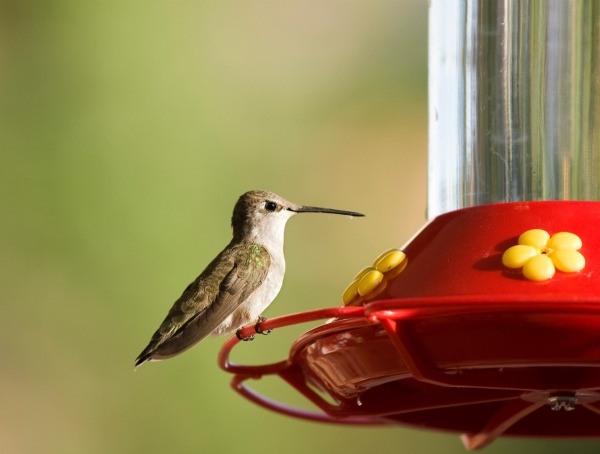
- #Homemade hummingbird feeder how to#
- #Homemade hummingbird feeder full#
In fact, rather than traditional sleep, hummingbirds can enter a deep resting period called “torpor”. They cannot walk or hop, but they do perch and rest! Hundreds of plant species rely on pollination by hummingbirds to produce or survive. They use their slender straw-like tongue to suck up nectar at over 20 laps per second. A very specialized tongue lives within that long beak! Hummingbirds long narrow beak and tongue are perfectly designed to access nectar deep within flowers. While hummingbirds do not have a sense of smell, they are attracted to bright colors. A hummingbird nest is about the size of a walnut shell, the eggs the size of a large jelly bean, and a newborn hummingbird is around the size of a penny! The female hummingbird does the work of building a nest, tending to eggs, and raising the young. They will pay special attention to the person who changes out their hummingbird feeder, and will even get sassy with you as a reminder that the feeder needs a refill! Hummingbirds also remember where the good feeders and gardens are, and will return to them year-after-year! In addition to flowers, hummingbirds also have the ability to remember and recognize people. They can remember every flower they have ever visited, and also know how long it takes for the flower to refill with nectar. On average, they fly at 25 to 30 mph – but can hit speeds of 50 mph during a dive! Hummingbirds can flap their wings at a rate of up to 200 times per second, depending on the species. A hummingbird’s heart beats over 1200 times per minute!. Ruby-throated hummingbirds are very common in the mid to eastern United States. The most common species in our Coastal California garden is the Anna hummingbird, along with a short visit from the extra-feisty Rufous hummers during their impressive annual migration between Mexico and Alaska. With over 350 different species of hummingbirds, this group is the second largest family of birds in the world. 

The more you know about them, the more you’ll appreciate what truly marvelous little creatures they are!

So let’s also talk about important hummingbird feeder best practices, including feeder location, cleaning, and maintenance.īut first, please enjoy these quick facts about hummers.
#Homemade hummingbird feeder how to#
Read along to learn how to make simple homemade hummingbird feeder nectar – the right way! We all have the best intentions to do more good than harm, right? Of course. If you’re interested in helping to support your local hummingbird population (and making new tiny friends while you’re at it) then you’ve come to the right place. It is also better for the birds than pre-made hummingbird food that often contains chemical dyes and preservatives! Homemade hummingbird food is very easy and inexpensive to make.
#Homemade hummingbird feeder full#
Hummingbirds are drawn to our yard because of the vast array of flowering plants we grow – some just for them! They are also attracted to the hanging feeder full of homemade hummingbird food that we provide. Watching hummingbirds play in the garden is one of the most pure and simple pleasures in life, IMHO! We are fortunate to have dozens of these quirky beautiful birds in our garden, and I absolutely adore them.







 0 kommentar(er)
0 kommentar(er)
